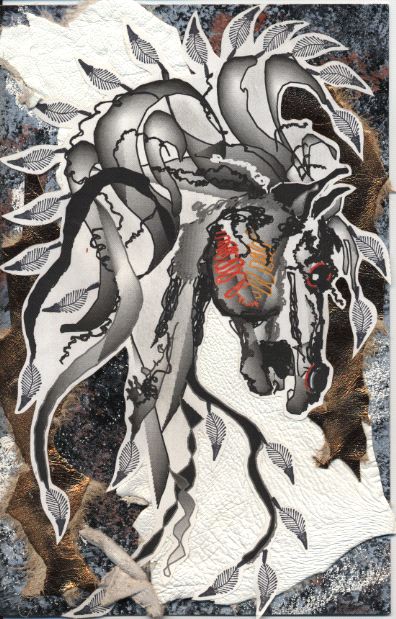
The ability for a visual work to capture one's attention is the hope of any visual artist. A second hope might be to further retain the attention of those same eyes. The more levels a scene works on, the greater the chance of this extended survey.
I met Jolene Meyer at Pam Klein's store in MO Inkleined to Stamp while on a brief workshop/demonstration tour through the state. Jolene had brought her scenes in to share with me and I knew immediately that my wish would be to add her pieces to the online gallery. She already had a body of work that would create a fairly extensive initial gallery. About a month later that wish came to pass and I started receiving files/submissions from her. As I watched these scenes coming through --first her existing pieces and then her latest creations-- I noticed that each consecutive scene seemed to add new elements of sophistication be it in composition, the dissection of individual components, lighting, highlighting, depth in color, play on textures and contrasts, etc. Her usage of the media and technique becoming more and more fluid to the point of it appearing effortless. Invisible. It's in this state that I believe an artist can create "moments of grace" within the boundaries of a format and elements begin to fire on all cylinders.
I'm enchanted by the overall compositions and am completely drawn into details of the scenes. The way the images were used, the way a sky moves, how the lighting on a water's surface glistens. Her scenes capture my mind and imagination where I find myself gazing into areas as if they were the ideal moments of actual physical locations in which they portray.
KN: Tell us a little about yourself. Where you grew up? Where you live, etc.? Pets?
JM: I am an old farm girl, born a pinch over half a century ago. Putting it that way sounds awful. Anyway, we lived on a farm in Illinois and a ranch in Texas; traveling back and forth. I went to school in Texas until 4th grade after which we permanently settled here in Illinois on the family farm. I had an interesting childhood thanks to my parents, especially my dad. He was a world traveler and through his travels, hobbies and interests we became accustomed to the rare and unique as ordinary. For instance, we had 40 peacocks running loose in our yard, great watch dogs, dinosaur bones in our hallway, a Brahma cow who followed my mom like a sheep and a pet Javalina (a wild pig from Texas) named Mikey, who adored my mother. Although a farmer by trade, dads interest in stones led him on rock hunting adventures all over the world, meeting people as varied as the stones he collected, and sometimes those same people would visit us. It was not uncommon to see visiting friends from Australia, Brazil, Canada or Mexico. My dad was one of a handful of pioneers to travel into Mexico to dig agates from the mines there. The trip was made on foot for the most part; my dad was in his 40's. When he was in his 60's he dug opals in Coober Pedy, Australia. He was really something. I have been sapphire hunting in Montana, toured a gold mine, rode a burro into Mexico, hunted javalinas on the ranch and flew over a raging volcano, which I didn't know was a raging volcano because I was only two years old. My parents bought me a horse when I was 7. I rode horses morning, noon, and night. We raised cattle so I had plenty of practice playing cowboys and Indians, until I became more interested in the cowboys I had horses the rest of my life. I was always drawing horses. My high school art teacher insisted that I concentrate on something other than equine art projects, but, I still like to draw horses.

I drew this horse using the computer mouse, cut out the horse and backed him with pieces of leather. The feathers were stamped. I am married, have two married children and four grandchildren, but still have babies to care for; the four-legged variety. Three Dobermans, my babies.
I also am an avid gardener. I've been canning my vegetables and fruits since I first was married, another case of not being able to separate the girl from the farm I suppose.
KN: How about your creative history? Have you done or do you do other visual arts or crafts?
JM: I can't think of much I haven't tried in the arts and crafts field. I've done a lot of sewing. I made my high school prom dress. When my children were small I sewed most of their clothes and mine. I made curtains, comforters and the like for the house. Every Christmas I would hand out all handmade gifts that I had worked on through the year. I've made dolls and stuffed animals, needlepoint, embroidery, knitting, by hand and machine, crochet, macrame, and leather tooling. I've made gun cases, belts, purses, wallets, photo album covers; you name it. I even considered making my own saddle, but my hands were giving out from all the tooling.
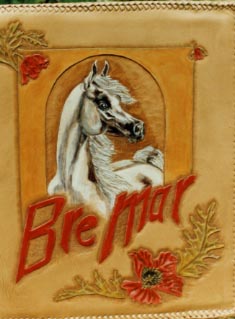
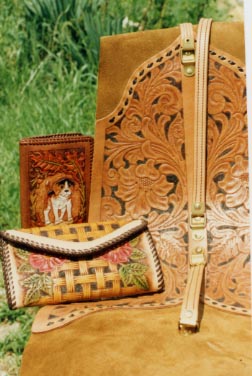
I've done bead work, made jewelry, and make my own paper for the stamped cards and scrapbooks. I spent 4 years doing the craft shows. I made my daughter-in-laws wedding dress; something I had never attempted. I caught the scrapbook bug. I love creating picture pages out of photos and I absolutely love photography. In fact, I wish I would have pursued photography.
KN: How and when did you get into rubber stamping?
JM: Well, stamping is just plain fun. I really didn't start stamping until about 5 years ago, but when I saw an article in the Rubber Stamper showing Kevin's work, I was intoxicated by his work. There were these incredible images of a brightly colored sky, and clustering clouds set off by blackened oak branches that seem to be immediately overhead. I just HAD to learn how to do that! Thus my quest began and led me to St. Genieve, Mo. where I met Pam Klein http://www.stampscapes.com/kleintalk.html of InKleined to Stamp. To me it was Stampscapes paradise. Here was a dealer who not only carried a well stocked inventory of the Stampscapes line, but, knew how to use them. She had Stampscapes experience, knowledge, enthusiasm and aptitude of these stamps. She graciously shared her wisdom with me, answered my questions and taught me many things. I must say Pam is a treasure. Since our first meeting, we have become good friends and I am so proud of that and of her.
KN: In regard to your work, where does your inspiration come from?
JM: Where does my inspiration come from? Life, experiences, television, observations; anything and everything. Things just pop into my head. Just look around this place we call mother earth, its loaded with ideas.
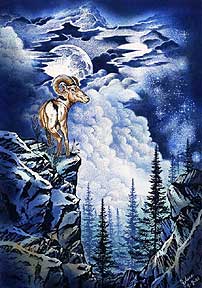
KN: When you approach a scene, what do you feel you're going after in a scene? What are the most important elements to you?
JM: Perfection! To capture my vision. To continually improve, learn and create; honing as many new techniques as I can absorb in one lifetime. I love to try everything and I pay close attention to details. The most important elements to me in a scene are probably balance and imagination. Balance entails all aspects of art to me; composition, perspective, and color, all have to be in harmony to bring to fruition that which your imagination created. Certainly for me, ideas are gifts from God, unique only to an individual. Ideas are the soul of creativity. Ideas are key. They are individual. They are what separates you from anyone else.
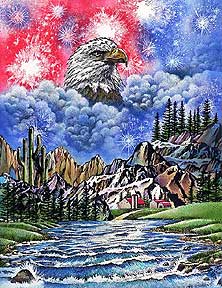
KN: What is your process? Do you do roughs or sketches or do you just go straight into it?
JM: After I have an idea, I start laying it out with the tracings to see how it fits together. I learned this technique from Pam Klein. She taught me to put all the stamp images on tracing paper so you can move them around and see how they look. No hit and miss this way. Then I see how the stamp components work into the plan. The idea may change a little from its conception, but that's OK. You may even further the original idea.
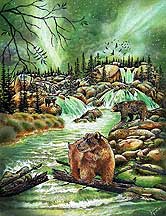
KN: How much do your scenes change?
JM: It depends on how the stamps fit the idea. I do think, though, that ideas feed off each other, so if during this laying out procedure I see something else to incorporate, it may change. I just keep experimenting, shuffling tracings around until I get what I set out for, or the closest thing to it.
KN: Is there a particular time of day that you stamp? Where do you stamp? What is the ideal situation for you? Do you like having music on? TV? Silence? Solitude?
JM: I love to get straight to work in the morning. I have the entire basement to myself. I can work for hours at a time, stopping only because of the mundane duties that have to be attended to, like fixing dinner, or doing laundry. Then I'm back at it. I turn on the radio, No TV. I really prefer quiet and solitude.
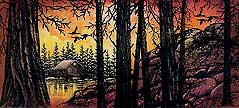
KN: What direction has your stamping gone from the time you started to now? Are you moving in a particular direction with your work?
JM: I try to challenge myself. I guess striving to be better is a course we all peruse in any field, i.e., crafts, hobbies, or our life's work. I just feel the need to create something and do the best I can. I do have a burning desire to learn and create. Stampscapes do indeed challenge my imagination. I want to push the envelope of my abilities.
KN: Is there anything else we didn't cover that would illuminate the viewer as to additional insight into your work?
JM: Yes, I think whenever a person feels passionate about a craft, they will be driven by the force of creativity. I am driven by this force. I will work on a scene for a month, if that's what it takes to produce the result I want, rather than speed through lesser quick images. I am not concerned about how long it takes to complete a project, just the end result. I do a lot of masking, and a lot of detail work. It is time well spent in the end. The Stampscapes line of art rubber stamps are unique. They allow a person to create innumerable images from the same stamps. Look beyond the initial image on your stamp. Use part of it, the middle of it, turn it backwards, look a texture or a line you can use. You will extend the creative possibilities of every stamp by experimenting.
As for color, I have no idea what to say about that. I guess color is in the eye of the beholder. Inks blend on paper just like any other medium; oils, watercolors, acrylics. If you stamp a blue background and then go back over it with red, you will get purples. Experiment, play; its fun. And on a personal note, Kevin Nakagawa is a gracious and accommodating gentleman who just happens to own this wonderful art stamp company called Stampscapes. He is a master at what he does and truly an inspiration to me. I will never forget the first time I saw his work.
KN: I'd like to thank Jolene for sharing some insight into her creative world and process. Whether it be in her compelling compositions, dramatic lighting, brilliant usage of the media, or otherwise, I would say that in no uncertain terms Jolene's work certainly captures and invites the eye in for further inspection into these --her personal visions of nature's perfection.